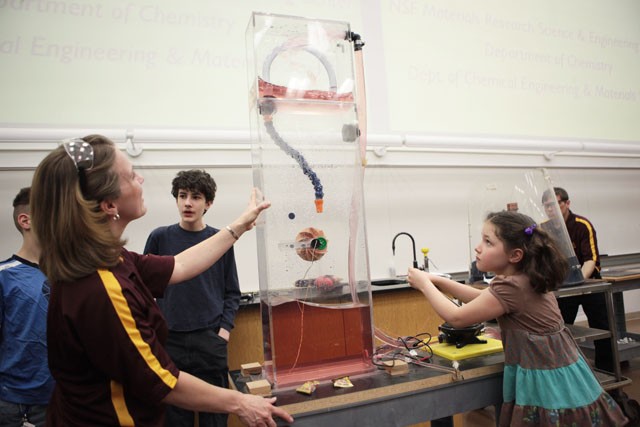Wearing maroon and gold T-shirts, University of Minnesota associate professors David Blank and Christy Haynes jogged into the Department of Chemistry auditorium in Smith Hall last week, fist-pumping to the sound of a backbeat.
Within moments, their âÄúEnergy and UâÄù presentation had 170 children dancing in the aisles. Then they added gummy bears and flaming hydrogen balloons and kids really went wild.
âÄúThe engineers and scientists of tomorrow âÄî thatâÄôs you guys!âÄù Blank said, pointing at his audience.
Blank, Haynes and a team of other chemistry department faculty and staff started the presentations in 2006 to get elementary and middle school kids âÄî especially from schools with a high level of poverty âÄî interested in studying science at the University.
The show taught students that energy cannot be created or destroyed but can be stored and its forms can be changed. The students learned how chemical reactions play a key role in that process.
With names like âÄúThe Hydrogen Ba-BoomâÄù and âÄúThe Methanol Rocket,âÄù noisy and flashy demonstrations drew screams of âÄúAwesome!âÄù and âÄúDo it again!âÄù from the crowd of mostly fourth graders.
Beyond the fun and games, the show addressed the more serious concerns of its creators, who detailed a two-fold problem. ThereâÄôs an impending energy crisis, they said, and a growing need for scientists and engineers to solve it.
In a rare serious moment, Blank explained to the audience that by 2050, it could take 25,000 Hoover Dams to power the earth at its current rate of energy consumption.
Haynes, an award-winning female scientist in a department where less than 15 percent of faculty members are women, said she hopes the presentation will inspire young girls to become scientists.
Although the disparity between the number of women and men scientists is still large, the situation is gradually improving.
âÄúWhen I was in third grade, a teacher said, âÄòGirls donâÄôt do science âÄî go to the craft table.âÄôâÄù
After the show, 9-year-old Kate Reimann, a fourth grader at Nuevas Fronteras Spanish immersion school in Cottage Grove, Minn., said she either wants to be an engineer or âÄúsomeone who makes the inside of an iPadâÄù when sheâÄôs older.
Students from Nuevas Fronteras made up about a third of the audience Thursday. Teacher Alyssa Ylonen said her students were engaged just being on a university campus and watching how science is done at the college level.
Ylonen said she had maxed out her field trip budget, but was able to add âÄúEnergy and UâÄù because the bus transportation costs were paid for by the UniversityâÄôs Materials Research Science and Engineering Center.
Other sponsors of the event included the National Science Foundation, Medtronic and the chemistry department.
A total of 2,700 public, charter and home-schooled students attended âÄúEnergy and UâÄù shows on campus last week.
Mickela Cupkie of Elko, Minn., brought her son Michael to the presentation through their co-op Homeschool Adventures. She said her son is a visual learner, so Cupkie taped the performance, planning to break it down further at home with him.
Since her degree wasnâÄôt in chemistry, Cupkie said attending the performance also re-educated her. Cupkie said sheâÄôll pass the knowledge on to the community by sharing it with other home-schoolers and the Boy Scout troop she helps lead.
Michael Cupkie, 11, said he wants to repeat some of the experiments at home.
âÄúBefore, I thought all balloons were good for was to hang them up at some kind of event âĦ but now theyâÄôve incorporated them with science,âÄù he said.
âÄúYou can never start too young,âÄù Blank said. âÄúYou canâÄôt fix the problem at the end of the pipeline.âÄù
The Chemistry King
Joe FranekâÄôs official title, âÄúLecture Demonstrations Director,âÄù blandly downplays the wicked coolness of his earsplitting, eye-popping science demonstrations.
Last weekâÄôs âÄúEnergy and UâÄù presentation was just one example of the work Franek does year-round.
He delivers chemistry demonstrations to 11 to 16 course sections a week âÄî about 500 demonstrations each fall or spring semester, he estimated.
ItâÄôs no trivial job. The Department of Chemistry even gave him his own lab to use as a workshop.
The demonstrations illustrate key chemical concepts and often involve dangerous chemicals.
âÄúI always got excited when he came in,âÄù said Phil Gaffney, a student who took a beginning chemistry class in the spring. âÄúIt was because it was an extra special demo that the teacher couldnâÄôt do herself.âÄù
Gaffney said his favorite reactions were explosive hand soap and a tinfoil boat that Franek floated on transparent gas.
Some of the demonstrations are easily prepared by filling a balloon with hydrogen. Others, he said, are more time consuming âÄî like the traveling wall of flame that involves shaking a chemical compound down 20 feet of track.
When aspiring students ask if he has plans to retire, Franek has a ready response.
âÄúI have no plans to leave anytime soon. ItâÄôs like working in a candy store!âÄù


